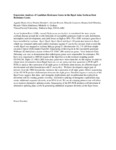Use este identificador para citar ou linkar para este item:
http://www.alice.cnptia.embrapa.br/alice/handle/doc/881697| Título: | Expression analyses of candidate resistance genes in the Rpp4 Asian Soybean Rust resistance locus. |
| Autoria: | MORALES, A. M. A. P.  BOREM, A.   LOUREIRO, M.   MOREIRA, R. S.   ABDELNOOR, R. V.   GRAHAM, M. A.   |
| Afiliação: | AGUIDA MARIA ALVES PEREIRA MORALES, UFV; ALUÍZIO BOREM; MARCELO LOUREIRO; RENATA STOLF MOREIRA; RICARDO VILELA ABDELNOOR, CNPSO; MICHELLE A. GRAHAM, USDA-ARS. |
| Ano de publicação: | 2010 |
| Referência: | 2010. |
| Conteúdo: | Asian Soybean Rust (ASR), caused Phakopsora pachyrhizi, is considered the most severe soybean disease around the world. Infection of susceptible genotypes leads to early defoliation, incomplete seed development, and yield losses as high as 80%. Five ASR resistance genes have been identified in soybean: Rpp1, Rpp2, Rpp3, Rpp4 and Rpp5. Of particular interest is Rpp4, which has remained stable and confers resistance against P. pachyrhizi isolates from around the world. Rpp4 was mapped to soybean linkage group G (chromosome 18), 1.9 cM from simple sequence repeat (SSR) marker Satt288. Sequencing of this region in the susceptible genotype Williams 82 identified a cluster of three CC-NBS-LRR resistance genes. Virus Induced Gene Silencing was used to demonstrate that orthologous genes were responsible for resistance. We have now sequenced a >460 kb region of the Rpp4 locus in the resistant mapping parent PI459025B. Eight CC-NBS-LRR resistance genes have been identified in this region. In order to obtain more information about Rpp4 function, we are using real time quantitative PCR (qRT-PCR) to analyze the expression of all eight genes in different plant tissues, in different stages of development and after inoculation with P. pachyrhizi. We have developed a single pair of primers from the NBD domain that monitors the expression of all eight genes. Direct sequencing of the RT-PCR product differentiates between the eight genes. Detailed sequence analyses of the Rpp4 locus suggest that intra- and intergenic duplications and recombination have played an important role in creating genetic diversity. Alternative splicing of intragenic duplications may create additional sequence diversity at an RNA level. We are developing primers that will allow us to monitor alternative splicing events. Sequencing of the RT-PCR products will determine if alternative splicing plays a role in generating additional sequence diversity at the Rpp4 locus. |
| Thesagro: | Fungo Doença fungica |
| NAL Thesaurus: | Soybean rust Fungal diseases of plants Disease resistance |
| Palavras-chave: | Ferrugem asiática da soja |
| Notas: | Edição de Poster da 11. Annual National Outreach Scholarship Conference, Raleigh. |
| Tipo do material: | Resumo em anais e proceedings |
| Acesso: | openAccess |
| Aparece nas coleções: | Resumo em anais de congresso (CNPSO)  |
Arquivos associados a este item:
| Arquivo | Descrição | Tamanho | Formato | |
|---|---|---|---|---|
| abdelnoor.conf..pdf | 21.24 kB | Adobe PDF |  Visualizar/Abrir |









